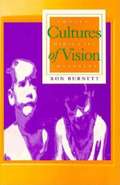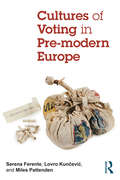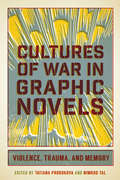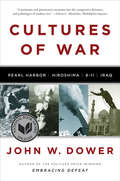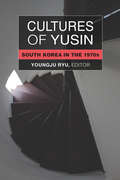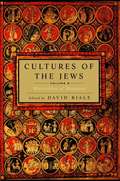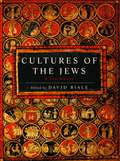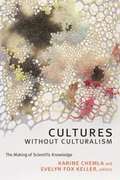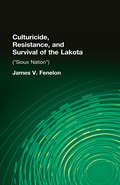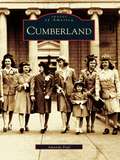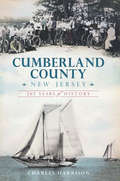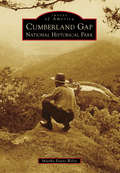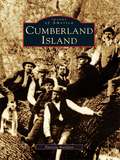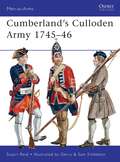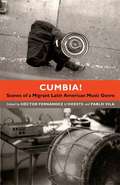- Table View
- List View
Cultures of Solidarity: Consciousness, Action, and Contemporary American Workers
by Rick FantasiaA commonplace assumption about American workers is that they lack class consciousness. This perception has baffled social scientists, demoralized activists, and generated a significant literature on American exceptionalism. In this provocative book, a young sociologist takes the prevailing assumptions to task and sheds new light upon this very important issue. In three vivid case studies Fantasia explores the complicated, multi-faceted dynamics of American working-class consciousness and collective action.
Cultures of Vision: Images, Media, and the Imaginary
by Ron Burnett"This is a very strong, thought-provoking [volume]... "--George MarcusAs home photographs shift from the print format to digital technology and as video moves from the television screen to multimedia, it is crucial to develop new strategies of interpreting and analyzing these images. Visit the author's World Wide Web site: (2/19/03: Link is no longer active)http://www.facl.mcgill.ca/burnett/englishhome.html
Cultures of Voting in Pre-modern Europe
by Miles Pattenden Evi 263 Serena. Ferente Lovro Kun 269Cultures of Voting in Pre-modern Europe examines the norms and practices of collective decision-making across pre-modern European history, east and west, and their influence in shaping both intra- and inter-communal relationships. Bringing together the work of twenty specialist contributors, this volume offers a unique range of case studies from Ancient Greece to the eighteenth century, and explores voting in a range of different contexts with analysis that encompasses constitutional and ecclesiastical history, social and cultural history, the history of material culture and of political thought. Together the case-studies illustrate the influence of ancient models and ideas of voting on medieval and early modern collectivities and document the cultural and conceptual exchange between different spheres in which voting took place. Above all, they foreground voting as a crucial element of Europe’s common political heritage and raise questions about the contribution of pre-modern cultures of voting to modern political and institutional developments. Offering a wide chronological and geographical scope, Cultures of Voting in Pre-modern Europe is aimed at scholars and students of the history of voting and is a fascinating contribution to the key debates that surround voting today.
Cultures of War in Graphic Novels: Violence, Trauma, and Memory
by Nimrod Tal Tatiana Prorokova Iain A. MacInnes Kenton Worcester Emir Pasanovic Harriet E.H. Earle James Kelley Joe Lockard Christina M. Knopf Peter C. Valenti Silvia G. Kurlat Ares Yasmine Nachabe TaanCultures of War in Graphic Novels examines the representation of small-scale and often less acknowledged conflicts from around the world and throughout history. The contributors look at an array of graphic novels about conflicts such as the Boxer Rebellion (1899-1901), the Irish struggle for national independence (1916-1998), the Falkland War (1982), the Bosnian War (1992-1995), the Rwandan genocide (1994), the Israel-Lebanon War (2006), and the War on Terror (2001-). The book explores the multi-layered relation between the graphic novel as a popular medium and war as a pivotal recurring experience in human history. The focus on largely overlooked small-scale conflicts contributes not only to advance our understanding of graphic novels about war and the cultural aspects of war as reflected in graphic novels, but also our sense of the early twenty-first century, in which popular media and limited conflicts have become closely interrelated.
Cultures of War: Pearl Harbor / Hiroshima / 9-11 / Iraq
by John W. DowerFinalist for the 2010 National Book Award in Nonfiction: The Pulitzer Prize-winning historian returns with a groundbreaking comparative study of the dynamics and pathologies of war in modern times. Over recent decades, John W. Dower, one of America’s preeminent historians, has addressed the roots and consequences of war from multiple perspectives. In War Without Mercy (1986), winner of the National Book Critics Circle Award, he described and analyzed the brutality that attended World War II in the Pacific, as seen from both the Japanese and the American sides. Embracing Defeat (1999), winner of numerous honors including the Pulitzer Prize and the National Book Award, dealt with Japan’s struggle to start over in a shattered land in the immediate aftermath of the Pacific War, when the defeated country was occupied by the U.S.-led Allied powers. Turning to an even larger canvas, Dower now examines the cultures of war revealed by four powerful events—Pearl Harbor, Hiroshima, 9-11, and the invasion of Iraq in the name of a war on terror. The list of issues examined and themes explored is wide-ranging: failures of intelligence and imagination, wars of choice and “strategic imbecilities,” faith-based secular thinking as well as more overtly holy wars, the targeting of noncombatants, and the almost irresistible logic—and allure—of mass destruction. Dower’s new work also sets the U.S. occupations of Japan and Iraq side by side in strikingly original ways. One of the most important books of this decade, Cultures of War offers comparative insights into individual and institutional behavior and pathologies that transcend “cultures” in the more traditional sense, and that ultimately go beyond war-making alone.
Cultures of Yusin: South Korea in the 1970s (Perspectives On Contemporary Korea)
by Youngju RyuCultures of Yusin examines the turbulent and yet deeply formative years of Park Chung Hee’s rule in South Korea, focusing on the so-called Yusin era (1972–79). Beginning with the constitutional change that granted dictatorial powers to the president and ending with his assassination, Yusin was a period of extreme political repression coupled with widespread mobilization of the citizenry towards the statist gospel of modernization and development. While much has been written about the political and economic contours of this period, the rich complexity of its cultural production remains obscure. This edited volume brings together a wide range of scholars to explore literature, film, television, performance, music, and architecture, as well as practices of urban and financial planning, consumption, and homeownership. Examining the plural forms of culture’s relationship to state power, the authors illuminate the decade of the 1970s in South Korea and offer an essential framework for understanding contemporary Korean society.
Cultures of the Fragment: Uses of the Iberian Manuscript, 1100-1600 (Toronto Iberic)
by Heather BamfordThe majority of medieval and sixteenth-century Iberian manuscripts, whether in Latin, Hebrew, Arabic, Spanish or Aljamiado (Spanish written in Arabic script), contain fragments or are fragments. The term fragment is used to describe not only isolated bits of manuscript material with a damaged appearance, but also any piece of a larger text that was intended to be a fragment. Investigating the vital role these fragments played in medieval and early modern Iberian manuscript culture, Heather Bamford’s Cultures of the Fragment is focused on fragments from five major Iberian literary traditions, including Hispano-Arabic and Hispano-Hebrew poetry, Latin and Castilian epics, chivalric romances, and the literature of early modern crypto-Muslims. The author argues that while some manuscript fragments came about by accident, many were actually created on purpose and used in a number of ways, from binding materials, to anthology excerpts, and some fragments were even incorporated into sacred objects as messages of good luck. Examining four main motifs of fragmentation, including intention, physical appearance, metonymy, and performance, this work reveals the centrality of the fragment to manuscript studies, highlighting the significance of the fragment to Iberia’s multicultural and multilingual manuscript culture.
Cultures of the Jews, Volume 2
by David BialeScattered over much of the world throughout most of their history, are the Jews one people or many? How do they resemble and how do they differ from Jews in other places and times? What have their relationships been to the cultures of their neighbors? To address these and similar questions, some of the finest scholars of our day have contributed their insights to Cultures of the Jews, a winner of the National Jewish Book Award upon its hardcover publication in 2002. Constructing their essays around specific cultural artifacts that were created in the period and locale under study, the contributors describe the cultural interactions among different Jews-from rabbis and scholars to non-elite groups, including women-as well as between Jews and the surrounding non-Jewish world. What they conclude is that although Jews have always had their own autonomous traditions, Jewish identity cannot be considered the fixed product of either ancient ethnic or religious origins. Rather, it has shifted and assumed new forms in response to the cultural environment in which the Jews have lived.Diversities of Diaspora, the second volume in Cultures of the Jews, illuminates Judeo-Arabic culture in the Golden Age of Islam; Sephardic culture as it bloomed first on the Iberian Peninsula and later in Amsterdam; and the Jewish-Christian symbiosis in Ashkenazic Europe. It also discusses Jewish culture in the Polish-Lithuanian Commonwealth; the culture of the Italian Jews of the Renaissance period; and representations of folklore and material culture through childbirth rituals throughout the Jewish diaspora.From the Trade Paperback edition.
Cultures of the Jews: A New History
by David BialeWho are "the Jews"? Scattered over much of the world throughout most of their three-thousand-year-old history, are they one people or many? How do they resemble and how do they differ from Jews in other places and times? What have their relationships been to the cultures of their neighbors? To address these and similar questions, twenty-three of the finest scholars of our day--archaeologists, cultural historians, literary critics, art historians , folklorists, and historians of relation, all affiliated with major academic institutions in the United States, Israel, and France--have contributed their insight to Cultures of the Jews. The premise of their endeavor is that although Jews have always had their own autonomous traditions, Jewish identity cannot be considered immutable, the fixed product of either ancient ethnic or religious origins. Rather, it has shifted and assumed new forms in response to the cultural environment in which the Jews have lived. Building their essays on specific cultural artifacts--a poem, a letter, a traveler's account, a physical object of everyday or ritual use--that were made in the period and locale they study, the contributors describe the cultural interactions among different Jews--from rabbis and scholars to non-elite groups, including women--as well as between Jews and the surrounding non-Jewish world. Part One, "Mediterranean Origins," describes the concept of the "People" or "Nation" of Israel that emerges in the Hebrew Bible and the culture of the Israelites in relation to that of the Canaanite groups. It goes on to discuss Jewish cultures in the Greco-Roman world, Palestine during the Byzantine period, Babylonia, and Arabia during the formative years of Islam. Part Two, "Diversities of Diaspora," illuminates Judeo-Arabic culture in the Golden Age of Islam, Sephardic culture as it bloomed first if the Iberian Peninsula and later in Amsterdam, the Jewish-Christian symbiosis in Ashkenazic Europe and in the Polish-Lithuanian Commonwealth, the culture of the Italian Jews of the Renaissance period, and the many strands of folklore, magic, and material culture that run through diaspora Jewish history. Part Three, "Modern Encounters," examines communities, ways of life, and both high and fold culture in Western, Central, and Eastern Europe, the Ladino Diaspora, North Africa and the Middle East, Ethiopia, Zionist Palestine and the State of Israel, and, finally, the United States. Cultures of the Jews is a landmark, representing the fruits of the present generation of scholars in Jewish studies and offering a new foundation upon which all future research into Jewish history will be based. Its unprecedented interdisciplinary approach will resonate widely among general readers and the scholarly community, both Jewish and non-Jewish, and it will change the terms of the never-ending debate over what constitutes Jewish identity.
Cultures of the Medieval Kingdom of Jerusalem: Frontier Inventiveness in the Age of the Crusades (Medieval Societies, Religions, and Cultures)
by Benjamin Z. KedarCultures of the Medieval Kingdom of Jerusalem is a revelatory portrait of the Frankish Levant at the time of the Crusades. Following victory in the First Crusade in 1099, the newcomers from Europe, or Franks, ruled a Christian kingdom in Jerusalem, then Acre, until 1291. Historians have written off this kingdom as a derivative cultural backwater. In this new social and cultural history, however, Benjamin Z. Kedar uncovers the striking inventiveness of the Frankish clerics and knights who settled in the kingdom and lived in it. Across an array of languages and archives, from textual and artistic to material and archaeological, Kedar maps the contours of the kingdom's cultureor, more accurately, its cultures. The Kingdom of Jerusalem was small, but the diversity of its population had no counterpart anywhere in the medieval West. Kedar explores how Franks, eastern Christians, Muslims, Jews, and Samaritans lived side by side in contentious times, each group developing or preserving its specific culture. Through stories of the lives of the kingdom's inhabitants, Kedar presents the remarkable creativity of the Franks in various fields as they faced challenges in new surroundings thousands of miles from their countries of origin. Cultures of the Medieval Kingdom of Jerusalem, the culmination of Kedar's half century of scholarship on the Crusades and the medieval Levant, is an innovative history of the Kingdom of Jerusalem.
Cultures of the West: Since 1350
by Clifford R. BackmanThe book highlights on the ways in which the major ideas like religion, science, and philosophy and passions of Western culture developed, internally, and how they interacted with the rest of the world.
Cultures of the West: To 1750
by Clifford R. BackmanCultures of the West focuses on the ways in which the major ideas and passions of Western culture developed internally and how they have shaped the Greater West -- for good and for ill. Comprehensive and geographically broad in scope, such key ideas as political and economic developments,intellectual and artistic ventures, and social trends and countertrends form the central narrative of this text.
Cultures without Culturalism: The Making of Scientific Knowledge
by Evelyn Fox Keller Karine ChemlaCultural accounts of scientific ideas and practices have increasingly come to be welcomed as a corrective to previous—and still widely held—theories of scientific knowledge and practices as universal. The editors caution, however, against the temptation to overgeneralize the work of culture, and to lapse into a kind of essentialism that flattens the range and variety of scientific work. The book refers to this tendency as culturalism. The contributors to the volume model a new path where historicized and cultural accounts of scientific practice retain their specificity and complexity without falling into the traps of culturalism. They examine, among other issues, the potential of using notions of culture to study behavior in financial markets; the ideology, organization, and practice of earthquake monitoring and prediction during China's Cultural Revolution; the history of quadratic equations in China; and how studying the "glass ceiling" and employment discrimination became accepted in the social sciences. Demonstrating the need to understand the work of culture as a fluid and dynamic process that directly both shapes and is shaped by scientific practice, Cultures without Culturalism makes an important intervention in science studies. Contributors. Bruno Belhoste, Karine Chemla, Caroline Ehrhardt, Fa-ti Fan, Evelyn Fox Keller, Kenji Ito, Guillaume Lachenal, Donald MacKenzie, Mary Morgan, Nancy Nersessian, David Rabouin, Hans-Jörg Rheinberger, Claude Rosental, Koen Vermeir
Cultures, Communities, and Conflict
by Paul Stortz E. Lisa PanayotidisCultures, Communities, and Conflict offers provocative, cutting-edge perspectives on the history of English-Canadian universities and war in the twentieth century. The contributors explore how universities contributed not only to Canadian war efforts, but to forging multiple understandings of intellectualism, academia, and community within an evolving Canadian nation.Contributing to the social, intellectual, and academic history of universities, the collection provides rich approaches to integral issues at the intersection of higher education and wartime, including academic freedom, gender, peace and activism on campus, and the challenges of ethnic diversity. The contributors place the historical university in several contexts, not the least of which is the university's substantial power to construct and transform intellectual discourse and promote efforts for change both on- and off-campus.With its diverse research methodologies and its strong thematic structure, Cultures, Communities, and Conflict provides an energetic basis for new understandings of universities as historical partners in Canadian community and state formation.
Culturicide, Resistance, and Survival of the Lakota: (Sioux Nation) (Native Americans: Interdisciplinary Perspectives)
by James V. FenelonThis ground-breaking work develops theories and methods of analyzing the United States' domination of Native Americans through a study of the Lakota society known as the Sioux Nation of Indians. Two centuries of struggle between nations and cultures during the U.S. expansion over North America are described utilizing policy (BIA) and cross-cultural (US-Lakota) history, with insightful additions to understanding the Tetonwan-Sioux. Contributing new forms of analysis to the study of attempted domination and destruction of Native American societies, the author explores the concept of culturicide in relation to theories of genocide and cultural domination. He links resistance by traditionalists and activists to cultural survival in charts of U.S. and Lakota policies and counter-policies. The study provides maps to identify struggles over land, and shows how social institutions have been used to attack Lakota culture. The author provides documented recent events to illustrate contemporary Lakota social life, often from an insider's point of view. The work provides a framework for understanding similar conflicts for other Native Nations. Also includes maps. James Fenelon is Dakota/Lakota, and is Assistant Professor of Sociology at John Carroll University. Bibliography. Index.
Culturing Life: How Cells Became Technologies
by Hannah LandeckerHow did cells make the journey, one we take so much for granted, from their origin in living bodies to something that can be grown and manipulated on artificial media in the laboratory, a substantial biomass living outside a human body, plant, or animal? This is the question at the heart of Hannah Landecker's book. She shows how cell culture changed the way we think about such central questions of the human condition as individuality, hybridity, and even immortality and asks what it means that we can remove cells from the spatial and temporal constraints of the body and "harness them to human intention." Rather than focus on single discrete biotechnologies and their stories--embryonic stem cells, transgenic animals--Landecker documents and explores the wider genre of technique behind artificial forms of cellular life. She traces the lab culture common to all those stories, asking where it came from and what it means to our understanding of life, technology, and the increasingly blurry boundary between them. The technical culture of cells has transformed the meaning of the term "biological," as life becomes disembodied, distributed widely in space and time. Once we have a more specific grasp on how altering biology changes what it is to be biological, Landecker argues, we may be more prepared to answer the social questions that biotechnology is raising.
Culver City Chronicles (American Chronicles)
by Julie Lugo CerraCulver City has rivaled Hollywood for nearly a century as the "Heart of Screenland"--a center of the movie and television trades. Here, the giant Metro-Goldwyn-Mayer evolved into Sony Pictures, and the Ince and Selznick movie empires became today's Culver Studios. But the same lands along Ballona Creek had been a wilderness traversed by Native Americans and settled by hardy Spanish pioneers named Machado, Talamantes and Higuera. Union soldiers occupied the area's Civil War-era Camp Latham. By 1910, visionary Harry H. Culver saw possibilities for these ranchlands and led Culver City to incorporate in 1917. Join official city historian Julie Lugo Cerra, a descendant of early settlers, as she relates the fascinating stories of how and why Culver City grew and prospered.
Cumberland
by Amanda PaulSettled on the banks of the Potomac River, Cumberland has watched time and progress stream through since its days as a fort in the colonial wilderness. Ascending the throne as the "Queen of the Alleghenies," the town became an essential transportation and industrial hub throughout the 19th and 20th centuries. Serving as the starting point for the National Road, the western terminus of the C&O Canal, and an important link along the B&O and Western Maryland Railroads, Cumberland attracted dozens of industries that churned out glass, textiles, tires, and even local brews. Prosperity and growth began to reshape the town, and soon distinct neighborhoods found their own identities while maintaining their strong links to Cumberland as a whole. Despite a post-war decline in its industrial sector, Cumberland continues to be a vibrant town of hardworking people who remain proud of their rich heritage and traditions. Selected from a variety of local sources, photographs in Images of America: Cumberland offer unique and memorable views of the people and places that have defined Cumberland over the past 150 years.
Cumberland
by Patrick H. StakemCumberland is known as the "Queen City of the Alleganys." The National Road, the Baltimore and Ohio Railroad, and the Chesapeake and Ohio Canal pass through the town, which was once an Ohio Company outpost and the westernmost part of the British Empire in North America. Cumberland has changed from a trading site to a manufacturing locality, to a tourist haven over many generations.
Cumberland County, New Jersey: 265 Years of History (Brief History)
by Charles HarrisonSituated along the Delaware Bay and first inhabited by the Lenape Indians, Cumberland County has a rich agricultural and industrial history. After the Revolution, Swedish, Danish and English immigrants were soon joined by others from across Europe and around the world. The Cohansey and Maurice Rivers flow through the county, uniting its cities and towns. They have distinguished histories of their own--Greenwich was a major port of entry in colonial America; Port Norris was the "oyster capital of the world" in the 1800s; and Seabrook Farms was the country's biggest vegetable factory. In 2013, the county celebrates its 265th anniversary. Join the people of Bridgeton, Millville, Vineland and the rest of Cumberland County to explore the stories from its past.
Cumberland Gap National Historical Park (Images of America)
by Martha Evans WileyBest known for its pivotal role in opening up the western frontier and its association with explorers and pioneers, the legendary Cumberland Gap has long been celebrated in music and literature. To better preserve that history, Cumberland Gap National Historical Park was authorized in 1940 and now covers more than 24,000 acres in Kentucky, Virginia, and Tennessee. Daniel Boone is remembered here, as well the Native Americans who used the path through the mountains for trade and warfare, the Civil War soldiers who took turns guarding this strategic portal, the geologists and industrialists who saw the potential for development, the businessmen who built one of the nation's first roads for automobile travel, and the displaced residents who gave up their homes for the park. The dream of a few dedicated individuals to one day restore the historic Wilderness Road through the Cumberland Gap came true in 2002 after decades of planning, and visitors can once again walk in the footsteps of the pioneers. Photographs spanning more than a century bring to life the fascinating stories and history of this pass.
Cumberland Island
by Patricia BarefootRich in history, wildlife, and beautiful coastal landscapes, Georgia's Cumberland Island attracts many an island tourist and nature lover. The island's well-preserved marshes, tidal creeks, and dune fields provide this hidden oasis with a rare natural charm. The area is also home to a wide variety of animal species, including loggerhead turtles, bob cats, manatees, and alligators, just to name a few. Though Cumberland is best known for being the nation's largest wilderness island, its history-dating back to the 16th century-also includes a period of use as a mission by the Franciscans. Among its historic sites are the magnificent ruins of Dungeness, the house built by the Carnegie family during the latter part of the 19th century, as well as the romantic Greyfield Inn. This pictorial history of Cumberland Island illustrates the people, places, and events that have shaped the area's cultural and natural history. The island's rare solitude and beauty, which have resulted from conservation and preservation efforts in the area, are captured in this carefully detailed book for all lovers of nature and history to enjoy. Though the island permits only very limited human traffic, these images allow the reader to appreciate the Cumberland landscape-laced with wild animals, pirate coves, English forts, and an African-American "settlement"-from afar.
Cumberland Township and Carmichaels (Images of America)
by Shelley Mcminn AndersonCumberland Township, located in the northeastern portion of Greene County, was one of Pennsylvania’s original townships. The history of this area shows that settlers were here prior to 1760. The settlement known as Old Town was founded in 1767. In 1796, Carmichaels was named in honor of Maj. James Carmichael, a Revolutionary War soldier and pioneer settler. Carmichael had traded his land in what is now the town of Jefferson for land owned by Thomas Hughes along the banks of Muddy Creek in Old Town. Carmichaels became home to the Greene Academy, notably, the first school of higher learning west of the Allegheny Mountains. The Carmichaels Covered Bridge spans Muddy Creek separating Old Town from Carmichaels. Both the Greene Academy and the Carmichaels Covered Bridge are listed on the National Register of Historic Places.
Cumberland's Culloden Army 1745-46
by Gerry Embleton Stuart ReidIn August 1745 Charles Edward Stuart, the 'Young Pretender', landed in Scotland and sparked the Second Jacobite Rising. The Jacobite forces seized Perth, then Edinburgh, where they proclaimed the Young Pretender's father King James VIII; they trounced their Hanoverian opponents at Prestonpans and crossed into England, getting as far south as Derby before withdrawing into Scotland. Far from universally popular north of the border, the Jacobite army bested another Hanoverian army at Falkirk and besieged Stirling, only to be routed by the Duke of Cumberland's army at Culloden in April 1746, a crushing defeat that ended any prospect of a Stuart restoration.Youngest son of Britain's Hanoverian king George II, the victorious general was lauded by his supporters while being reviled by his opponents as 'Butcher' Cumberland. His polyglot army, the subject of this book, included English regular Line infantry, cavalry, artillery, marines, and Scottish infantry (more Scots served on King George's side than followed 'Bonnie Prince Charlie'); English and Scottish 'provincial' infantry and cavalry regiments; and Hanoverian, Hessian, Dutch and Swiss infantry, cavalry and artillery.Featuring full-colour artwork depicting the distinctive uniforms of Cumberland's men, this exhaustively researched study offers a wealth of detail of regimental strengths and casualties and includes an extended chronology that places individual units in specific places throughout the campaign that culminated at Culloden.
Cumbia!: Scenes of a Migrant Latin American Music Genre
by Fernández L'Hoeste Héctor D. Vila PabloCumbia is a musical form that originated in northern Colombia and then spread throughout Latin America and wherever Latin Americans travel and settle. It has become one of the most popular musical genre in the Americas. Its popularity is largely due to its stylistic flexibility. Cumbia absorbs and mixes with the local musical styles it encounters. Known for its appeal to workers, the music takes on different styles and meanings from place to place, and even, as the contributors to this collection show, from person to person. Cumbia is a different music among the working classes of northern Mexico, Latin American immigrants in New York City, Andean migrants to Lima, and upper-class Colombians, who now see the music that they once disdained as a source of national prestige. The contributors to this collection look at particular manifestations of cumbia through their disciplinary lenses of musicology, sociology, history, anthropology, linguistics, and literary criticism. Taken together, their essays highlight how intersecting forms of identity--such as nation, region, class, race, ethnicity, and gender--are negotiated through interaction with the music. Contributors. Cristian Alarcón, Jorge Arévalo Mateus, Leonardo D'Amico, Héctor Fernández L'Hoeste, Alejandro L. Madrid, Kathryn Metz, José Juan Olvera Gudiño, Cathy Ragland, Pablo Semán, Joshua Tucker, Matthew J. Van Hoose, Pablo Vila

